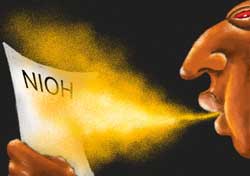 |
INDUSTRY’S NEMESIS
A report by the National Institute of Occupational Health nails endosulfan. Is that why
the pesticide establishment wants to keep it under wraps? |
In August 2001, the
National Human Rights Commission (NHRC) asked the Indian Council of Medical Research
(ICMR) to submit a report on the health hazards due to the spraying of endosulfan in
cashew plantations in Kasaragod district within four months. ICMR in turn asked the
National Institute of Occupational Health (NIOH), Ahmedabad, to send a team to Kerala.
 A three-member NIOH team — comprising NIOH
director H N Saiyed, deputy director Aruna Dewan and H R Rajmohan of the Regional
Occupational Health Centre (ROHC), Bangalore — visited the district on August 9-11
and then again in September. They had a clear mandate: a cross-sectional environmental
epidemiological study to investigate the disease pattern in the affected villages and a
control population. The team was headed by Saiyed and comprised members from NIOH, ROHC
and the department of pediatrics, Kasturba Medical College, Mangalore. The field study was
conducted from September 24 to October 7. In the first phase, blood samples of 262
schoolchildren (170 exposed and 92 control) were collected for detecting endosulfan
residues, hormonal analysis, thyroid hormones, sex hormones and cytogenetic studies.
A three-member NIOH team — comprising NIOH
director H N Saiyed, deputy director Aruna Dewan and H R Rajmohan of the Regional
Occupational Health Centre (ROHC), Bangalore — visited the district on August 9-11
and then again in September. They had a clear mandate: a cross-sectional environmental
epidemiological study to investigate the disease pattern in the affected villages and a
control population. The team was headed by Saiyed and comprised members from NIOH, ROHC
and the department of pediatrics, Kasturba Medical College, Mangalore. The field study was
conducted from September 24 to October 7. In the first phase, blood samples of 262
schoolchildren (170 exposed and 92 control) were collected for detecting endosulfan
residues, hormonal analysis, thyroid hormones, sex hormones and cytogenetic studies.
It is significant that
the NIOH team decided to select a control group. A control group is comparable with the
exposed group in all respects, except for the exposure, which in this particular study was
endosulfan.
The NIOH report indicates
that endosulfan is the cause for a number of health problems among schoolchildren living
in the exposed area. These children had significantly lower intelligence level then the
control group. They also had a very high incidence of various sexual disorders when
compared to control group (see box: What the report says).
WHAT THE REPORT SAYS
Two months after the spraying, FIPPAT study did not find endosulfan residues. This
is what NIOH found 10 months later. Even months after the spraying, blood samples of young
children had deadly endosulfan residues. Remember, there is no standard for this pesticide
in blood because there is no safe level.
|
Total endosulfan residue
(in parts per billion (ppb) |
| Water in pond near Kodenkiri stream |
0.0667 |
| Well water near school |
0.0209 |
| Well water near house |
0.0204 |
| Blood samples of children from
Vaninagar school |
| Code 1 |
78.74 |
| Code 4 |
28.44 |
| Code 6 |
48.09 |
| Code 104 |
33.57 |
CONGENITAL ABNORMALITIES:
Significantly higher in the exposed group of females as compared to the control group.
Congenital heart and skeletal abnormalities were also high. Exposure linked to genotoxic
agent, which could be endosulfan in this case.
| |
Control (% of people affected in the
group) |
Exposed (% of people
affected in the group) |
| Congential abnormalities |
1.09 |
5.8 |
NEUROLOGICAL PROBLEMS: Significantly
higher prevalence of learning disabilities, low IQ and scholastic backwardness were found.
Exposure to some neurotoxic agent, possibly endosulfan, during development stages.
| |
Control (% of people affected in the
group) |
Exposed (% of people
affected in the group) |
| Learning disability |
2.60 |
10.7 |
| Retained in same class |
13.50 |
20.40 |
ABNORMALITIES IN REPRODUCTIVE
SYSTEM: Findings are striking and point to exposure to an endocrine
disruptor. Girls attain menarche early, menstrual disorders frequent. Boys’ puberty
delayed. Signify exposure to oestrogenic substances and endosulfan is experimentally shown
to have oestrogenic effects.
| |
Control (% of people affected in the
group) |
Exposed (% of people
affected in the group) |
| Menstrual disorders |
4 |
21.80 |
|
The report was finalised
in March 2002, but has been kept confidential. Only a few are privy to the findings. Down
To Earth managed to get hold of the report, of which only a few copies are available.
Most activists and the media don’t have any clue about the findings. "Has this
damning report been kept secret because it clearly implicates the pesticide
industry," asks Jayakumar C of Thanal, a Thiruvananthapuram-based non-governmental
organisation.
NEXT>>>